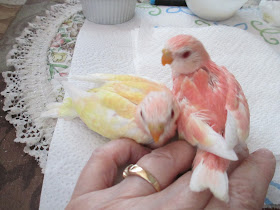The year 2018 was full of health issues for my husband and
me. Although recovering from surgery, I’ve answered questions sent to
rosie.birds@gmail.com. Haven’t shared them on this website and should have.
Here is a recent inquiry about Bourke Parakeets and my response. Blessings all!
------------------------------
QUESTION
I understand that Bourke's can be difficult to determine
gender until they molt (I would assume most especially the Lutinos and
rosies). That being said, will two males
or two females get along well? What if
one baby is a male and the other a female...will they copulate later if there
is no nest box for them? –Dana
ON MATING:
Once sexually mature, a male and female of any variety will
want to mate when conditions are right for them, even if they’re brother and
sister, or there is an age difference. We had a pair that bickered with each
other all the time, yet still produced offspring. Once their mates were
switched the bickering stopped. They didn’t like each other, but still mated.
With new mates they were both happier.
It’s long days that
stimulate egg laying in all hens, and many will lay even when no male is
present. The presence of a nest box helps stimulate egg laying, but isn’t always
a requirement for an eager hen. Eggs, of
course, will be infertile. Chicken houses use artificial lighting to stimulate
egg laying, and we do the same in our homes if lights are left on in a bird’s
room into the evening or early in the morning. By extending “daylight” when
normally it would be dark, hens react.
With Bourkes the male typically investigates a nesting area
to be sure it is safe for the hen. Some Bourke hens ask to mate even when there
is no nest box available, but most males won’t mate until there’s a safe place
for her to lay her eggs. That is usual behavior in the majority of Bourke pairs,
but occasionally may differ in some pairs.
We have one pair that are mating right now, but she’s not
laying eggs. In another month or so they will get a nest box. I’ve tried to
limit the number of hours of light they are exposed to and I believe that’s why
she’s not laying yet. The fact that they are mating anyway is very unusual for
birds. They are also a very young pair.
SAME SEXES IN A CAGE TOGETHER:
Putting birds together while young is the best option. Youngsters
always accept one another.

That said, usually Bourkes get along well with other Bourkes
and other varieties of small birds. However, placing a mature bird in with
another mature bird needs to be done slowly by introducing them first.
One might decide to protect his or her home
from the stranger. It’s wise to put their cages beside one another, but not put
the birds together in the same cage yet. Give them several days or longer to
get acquainted.
Chasing occurs most often during mating season when there is
competition between birds. Hens will chase other hens away and males will chase
other males. If there are only two of the same sex and none of the opposite sex
in their cage, chasing isn’t likely to happen. In fact, Bourkes are happier if
they are not alone in a cage. A companion, even of the same sex, is
appreciated.
We kept a male Bourke and a male Linnie together. Both were
tame and they became good friends.
SEXUAL IDENTIFICATION:
This is covered elsewhere on the blog. If you enter Sexing
in the Search Box, it will find other posts. Briefly, Normal (wild-colored)
brown Bourkes are easiest to identify once mature. Males have a tiny line of
blue feathers on their brow above the cere (nostrils). Hens don’t have this,
neither do very young birds.
Bourkes of every other color can be DNA’d by a reputable veterinary
laboratory that does Avian DNA testing. Often Rosy hens will have darker faces than the males do, but this is open to a wide variation and unreliable. Or, sometimes the sex of the parent
birds gives a clue to the likely sex of the offspring. This is not full proof either,
but if the parents are two different colors from one another, it helps. Most
baby Bourkes become the color of the sex of their opposite parent. In other
words, a Rosy male is likely to produce Rosy hens. Likewise, if the mother is a
Normal, she is likely to produce Normal sons. Again, this is not 100% accurate.
Grandparents and other ancestors play a role too. Experience with past clutches
verifies how well this works with a certain pair or birds.
Other than that, we must depend upon the behavior of the Bourkes
to tell us their sex. Males will often do a “strut” by standing tall with
shoulders back and wings slightly flared open at the shoulders. This is most
often done toward other males. Hens will sometimes squat down, chests forward
and tails up in the air, cheeping. However, I’ve seen mature, mated males do
this in front of their hens as if to tell them what they want them to do. A few people claim you can tell a Bourke's sex by how it stands on the perch and will describe differences in how a male vs. female stands. I believe it's nonsense.
In all feathered animals the sex of the offspring is determined by the
hen, unlike in humans where the father determines a baby’s sex. There is more
on this in other posts as well.
Don’t fail to get a copy of my book on Small Exotic Birds.
Below is a link to it on Amazon in the USA. It is also available from other
booksellers in the USA, or from Amazon in the UK, and available from Amazon.com in most other countries.
Peace and Blessings.












